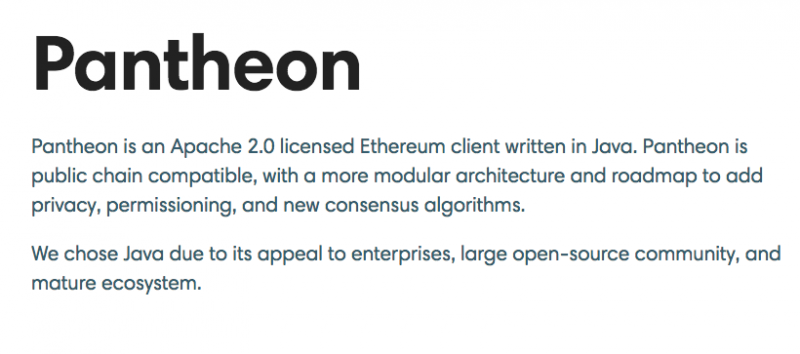PegaSys, the protocol engineering team at ConsenSys has released Pantheon, an open source Ethereum client developed under the Apache 2.0 license and written in Java, which will be the center of the company’s future enterprise tools, the company announced in a Medium post on October 30, 2018.
Pantheon Core Client Focuses on Enterprise Ethereum Adoption
PegaSys, the protocol engineering team at ConsenSys has announced the long-awaited open source release of Pantheon Core. The new Ethereum client is part of PegaSys’ mission of building enterprise-grade solutions in tandem with the Ethereum community, which will include private transactions and permissioning.
According to the company’s October 30 Medium post, the new update will enable users to run nodes to connect to the Ethereum mainnet, Rinkeby or Ropsten testnets, or create their own private networks.
Pantheon Core is currently updated to the Constantinople release and implements multiple consensus algorithms, including Proof of Work (PoW) and Proof of Authority (clique PoA) for fast private networks. PegaSys said that the IBFT 2.0 update will be coming along with the next release.

(Source: Pegasys)
The Pantheon client currently supports ether token mining and common smart contract and decentralized application (DApp) development. The new release also features deployment and operational use cases, using tools such as Truffle, Remix, and web3j.
The Motivation behind Creating Pantheon
Released on October 30, 2018, at Devcon4, the annual Ethereum developers event, Pantheon is described as the core of Pantheon Enterprise, which will add permissioning and privacy as additional modules.
“Our motivation to contribute a new client is threefold: to build something that can get to enterprise production, to support and scale mainnet, and to prepare for the future of Enterprise Ethereum,” PegaSys said about the motivation behind creating Pantheon.
The 50-strong development team dedicated to the project said that all of its design and architecture decisions have been aimed at clean interfaces and modularity. The company’s primary goal was to make Pantheon a platform for others to build on and create new modules for consensus, privacy, databases, and analytics.
All of the modules can then be configured as needed by an enterprise to suit a production environment, with PegaSys aiming to provide technical support eventually all the way up to enterprise-grade.
And while neither PegaSys nor ConsenSys didn’t give a detailed timeline of their planned releases, they confirmed that an Enterprise Alpha is expected to be released in the first half of 2019, with a production-grade client to be released “some months afterward.”
In the meantime, the team will be working on critical challenges related to Ethereum scaling, privacy, security, and collaborations with the Enterprise Ethereum Alliance (EEA) as well as other standards bodies like W3C and IEEE to review specifications and provide inputs.
Category: Blockchain, Business, Development, Ethereum, News
Tags: blockchain technology, ConsenSys, EEA, enterprise, Ethereum, Pantheon, PegaSys, W3C







